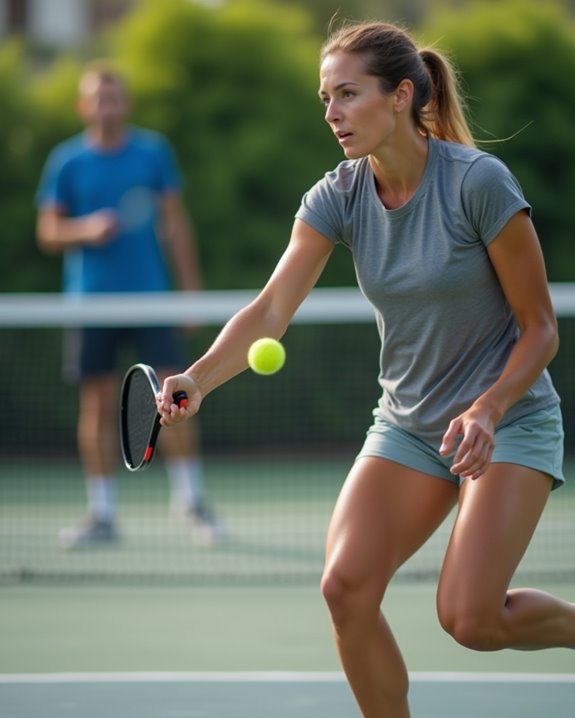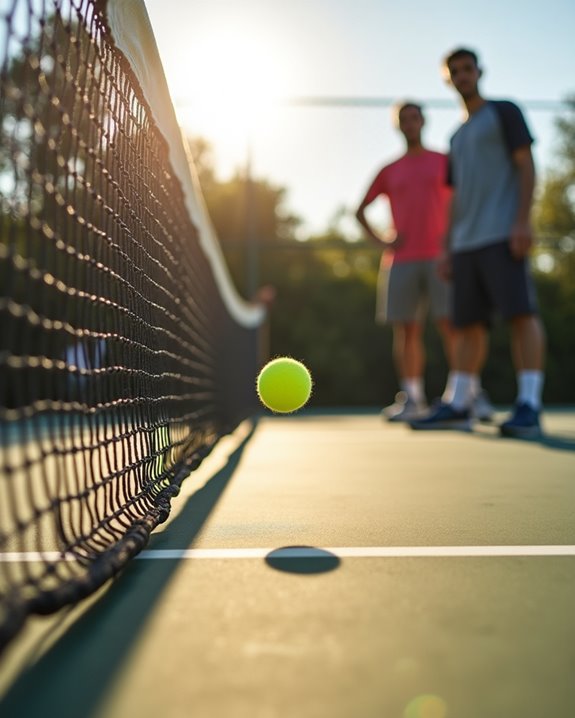A dink is pickleball’s equivalent of a chef’s delicate julienne—a soft, finesse shot that arcs over the net and lands in your opponent’s kitchen (non-volley zone). You’ll want to maintain a 3-4 grip strength, keep your paddle out front like you’re prepping ingredients, and make contact with the ball ahead of your body. This strategic shot forces opponents into defensive positions and helps you control the game’s flavor. Master this technique to serve up more advanced tactics later.
Key Takeaways
- A dink is a soft, arcing shot that lands in your opponent’s non-volley zone, requiring finesse rather than power.
- Maintain a relaxed grip (3-4 out of 10 strength) and compact swing to ensure control and prevent pop-ups.
- Position yourself in an athletic stance with bent knees and paddle out front for optimal dinking readiness.
- Always make contact with the ball in front of your body while keeping your swings short and controlled.
- Practice crosscourt dinking to create difficult angles and target your opponent’s backhand for strategic advantage.
What Is a Dink Shot and Why It Matters
The gentle art of dinking is pickleball’s equivalent of a chef’s delicate sauce reduction – subtle, controlled, and absolutely essential to master. When you’re dinking at the kitchen line, you’re executing a soft shot that gracefully arcs over the net and lands in your opponent’s non-volley zone.
Think of it as carefully seasoning a dish – too much power and you’ve ruined it; too little and it lacks impact. You’ll find that mastering this fundamental technique gives you tactical control of rallies, allowing you to set up winning plays while forcing opponents into defensive positions.
Proper dinking requires contacting the ball in front of your body with a compact swing – like a chef’s precise knife work. It’s your pathway to consistency, precision, and ultimately, pickleball success.
The Perfect Ready Position for Effective Dinking
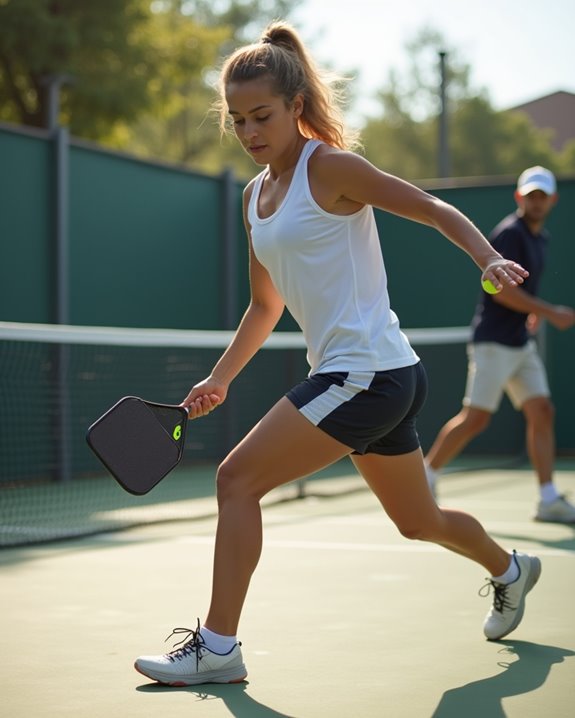
Now that you’ve grasped what makes a dink shot so valuable, let’s set up your kitchen for success! Your ready position is the secret ingredient to dinking mastery.
Start by slightly bending your knees in an athletic stance—like a chef ready to slice precision ingredients. Keep your paddle out front, grip relaxed but firm, as if holding your favorite spatula. Don’t get caught flat-footed! Your weight should be balanced, allowing you to spring toward any incoming shot.
This foundation helps you anticipate the ball’s trajectory, just as a cook watches rising dough. Practice your ready position daily; it’s the mise en place of pickleball preparation. When you maintain proper form at the kitchen line, your dinking consistency will sizzle, and opponents will find your shots increasingly difficult to return.
Mastering the Grip: Finding Your 3-4 Strength
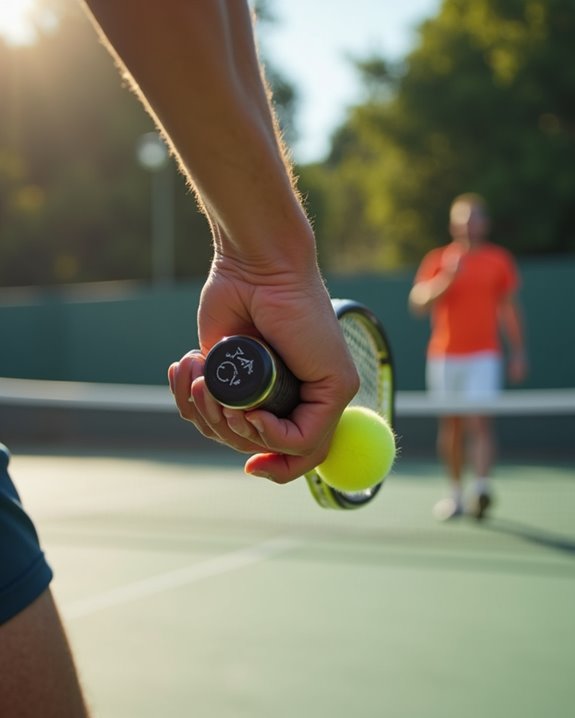
While many players focus on footwork and positioning, your grip strength actually serves as the secret sauce in your dinking recipe. Think of your grip as seasoning—too much overpowers the dish, too little leaves it bland.
Aim for a 3-4 on the grip-strength scale (out of 10). This golden-zone pressure allows you to control the paddle face with precision while preventing unwanted pop-ups. You’re looking for that perfect simmer, not a rolling boil!
Avoid death-gripping your paddle. Instead, let your legs and core do the heavy lifting while your relaxed grip guides the ball. Minimal wrist movement is essential—think of your forearm and paddle as a single utensil folding ingredients together. Practice this measured grip strength, and you’ll serve up consistent, controlled dinks every time.
The Optimal Contact Zone for Consistent Dinks
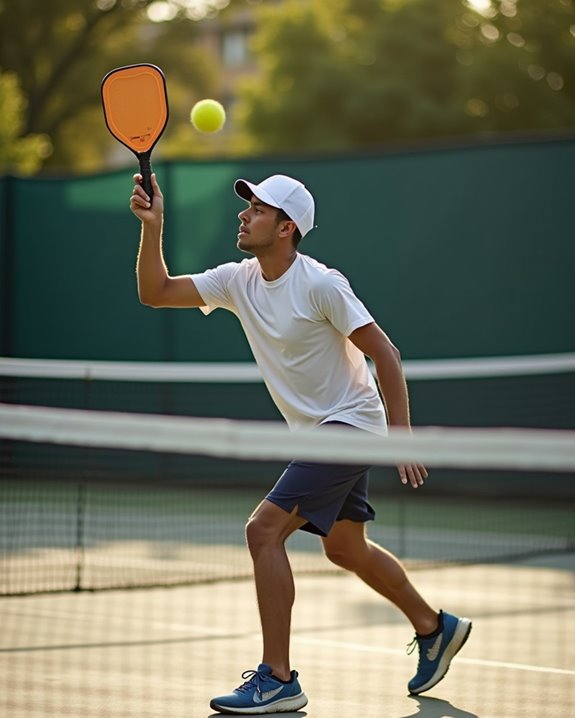
Finding the sweet spot for your dink shot requires attention to where you’re “plating” the ball in relation to your body. Your ideal contact zone should be between waist and shoulder height—think of this as your pickleball kitchen counter where preparation happens!
Always aim to connect with the ball in front of you, just like a chef keeping ingredients within easy reach. When you stray from this zone—hitting too high (like an overcooked soufflé) or too low (like dropping dough on the floor)—your dinks lose their delicate flavor and accuracy.
With consistent practice in this prime zone, you’ll develop muscle memory that serves up reliable dinks every time. Try the “Protect the Castle” drill to simmer your technique to perfection. Your body will begin to instinctively find this sweet spot!
Common Dinking Mistakes to Avoid
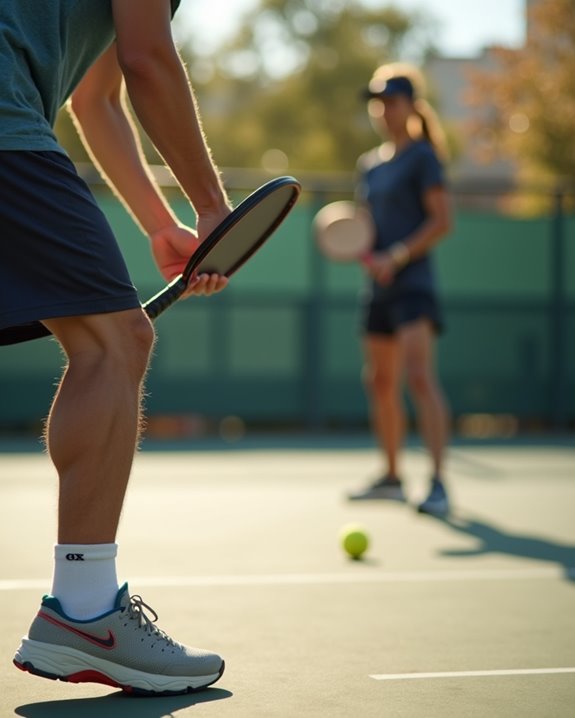
Even the most seasoned pickleball chefs can fold these common dinking errors into their game without realizing it! Think of your body as the cutting board and the ball as your main ingredient—you’ll want to make contact out front, not behind your body where it creates unwanted upward momentum like an overflowing soufflé.
Don’t step back from the kitchen line—that’s like abandoning your station mid-recipe! Large backswings are another common mistake; they’re the equivalent of using a cleaver when you need a paring knife. Keep your swings compact and controlled.
Remember to return to your position at the kitchen line after every shot, maintaining readiness for the next ball. This recovery step guarantees you’re always perfectly positioned to serve up another delicious dink!
Compact Swing Mechanics for Better Control
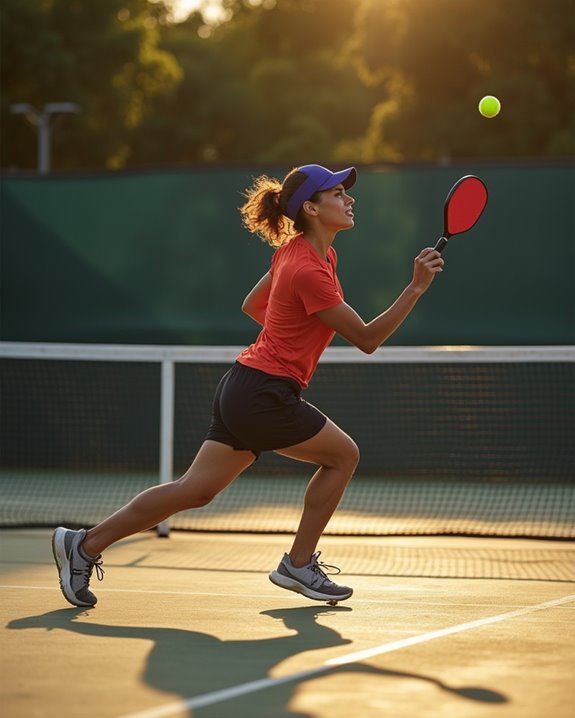
Three essential ingredients make up the perfect dink recipe: minimal backswing, precise contact, and controlled follow-through. Think of your compact swing as preparing a delicate soufflé—too much movement and it collapses!
Keep your paddle’s journey short and sweet by limiting your backswing. You’ll want to fold in power from your legs and core rather than overextending your arm. Imagine your paddle as a chef’s knife—controlled precision beats wild chopping every time.
For best results, maintain a relaxed grip (3-4 out of 10) and contact the ball in front of your body. This creates a direct path to your target, like drizzling sauce precisely where you want it. Your compact swing guarantees each dink is served with consistency and control, preventing those unwanted high pops your opponents are hungry to attack.
Crosscourt Dinking Strategy and Execution

When you’ve mastered the straight dink, crosscourt dinking becomes your secret sauce for elevating your pickleball game. This technique sends the ball diagonally to your opponent’s kitchen, creating angles that are tough to return—like serving a dish that’s impossible to resist.
For the perfect crosscourt dink recipe, aim for your opponent’s backhand—it’s often their weaker side. Keep your swing compact, folding it like you’d gently fold egg whites into a soufflé. This prevents sending the ball too high, where it becomes an appetizing opportunity for your opponent to smash.
Try the “Protect the Castle” drill to sharpen your technique. It’ll improve your footwork and positioning, ensuring you’re always balanced and ready to serve up your next shot.
The “Protect the Castle” Drill for Practice

Now that you’ve got the crosscourt dinking technique simmering, let’s explore the “Protect the Castle” drill that’ll transform your kitchen game from amateur to gourmet.
This delicious drill serves up targeted practice by having you dink back and forth at specific spots—imagine you’re precisely placing garnishes on a gourmet dish! You’ll want to contact the ball in front of your body, using short, compact strokes rather than wild backswings. Think of it as delicate knife work rather than chopping with a cleaver.
What makes this drill so appetizing for beginners is how it builds confidence at the kitchen line while developing your shot placement precision. Regular practice will have you dinking with the finesse of a seasoned chef, leaving opponents unable to penetrate your defensive “castle.”
Transitioning From Dinks to Attack Opportunities

The art of shifting from a defensive dink to an offensive strike resembles a chef sensing the perfect moment to turn up the heat. You’ll know it’s time to attack when your opponent serves up a high, soft dink that’s just begging to be smashed.
Stay in your ready position as you exchange dinks—like a chef poised over a simmering sauce. This preparation allows you to pounce when opportunity arises. Watch for opponents who step back or reach uncomfortably for your well-placed dinks.
The patient pickleball player hovers attentively, ready to capitalize when opponents overreach—just as a watchful chef awaits the perfect cooking moment.
Communication with your partner is essential! A quick “mine” or “yours” guarantees you’re both reading from the same recipe. Practice shifting between gentle dinks and aggressive attacks during drills to develop that sixth sense of timing.
Remember: patience in dinking creates the perfect ingredients for your attacking feast.
Drilling Routines to Improve Your Dinking Game
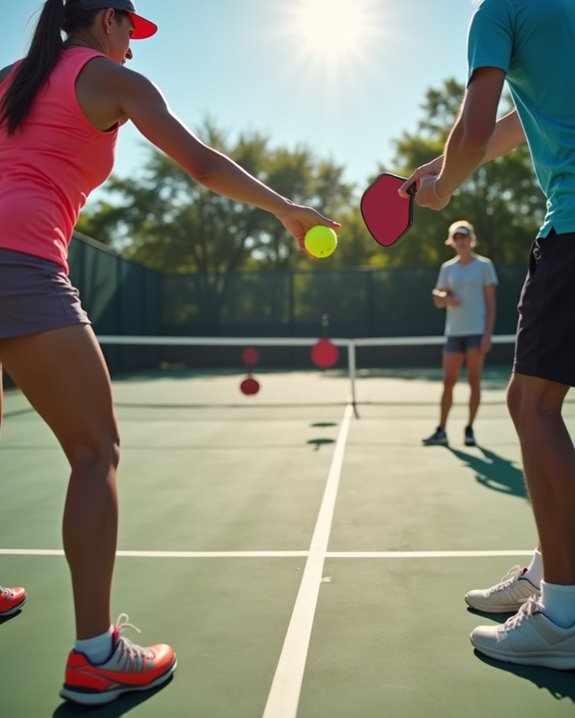
Four essential drilling routines can transform your dinking skills from amateur to professional, much like how a chef refines their knife techniques through deliberate practice. Start with the “Protect the Castle” drill, where you’ll aim for specific targets while dinking back and forth in the kitchen.
Always maintain a proper ready position—knees slightly bent, paddle out front—just as you’d prepare your station before cooking. When executing your dinks, use a grip strength of 3-4 on a 10-point scale; this light touch prevents popups while maintaining control.
Keep your swings short and compact. Think of it as precise chopping rather than wild stirring. Finally, practice crosscourt dinking regularly to develop your court awareness and strategic shot placement, essential ingredients for an advanced dinking game.
Frequently Asked Questions
How to Dink in Pickleball for Beginners?
For effective dinking techniques, keep your knees bent, paddle forward, and use light grip pressure. Make contact with the ball in front of you and practice short, compact swings rather than large backswings.
What Is the Rule for Dinking in Pickleball?
When dinking, you can’t step in the kitchen (non-volley zone) while hitting the ball. Your dink strategy should focus on keeping your feet behind the line and landing soft shots in your opponent’s kitchen.
What Is the 10 Second Rule in Pickleball?
Like a countdown to liftoff, you’ve got just 10 seconds to serve after the score’s announced. While mastering dinking strategies is important, this time limit keeps the game flowing smoothly—don’t let the clock run out!
What Is the Golden Rule in Pickleball?
The Golden Rule requires you to let the ball bounce once on each side before volleys. It’s fundamental to your dinking strategy, ensuring you’re properly positioned before engaging in those controlled, soft shots near the net.

